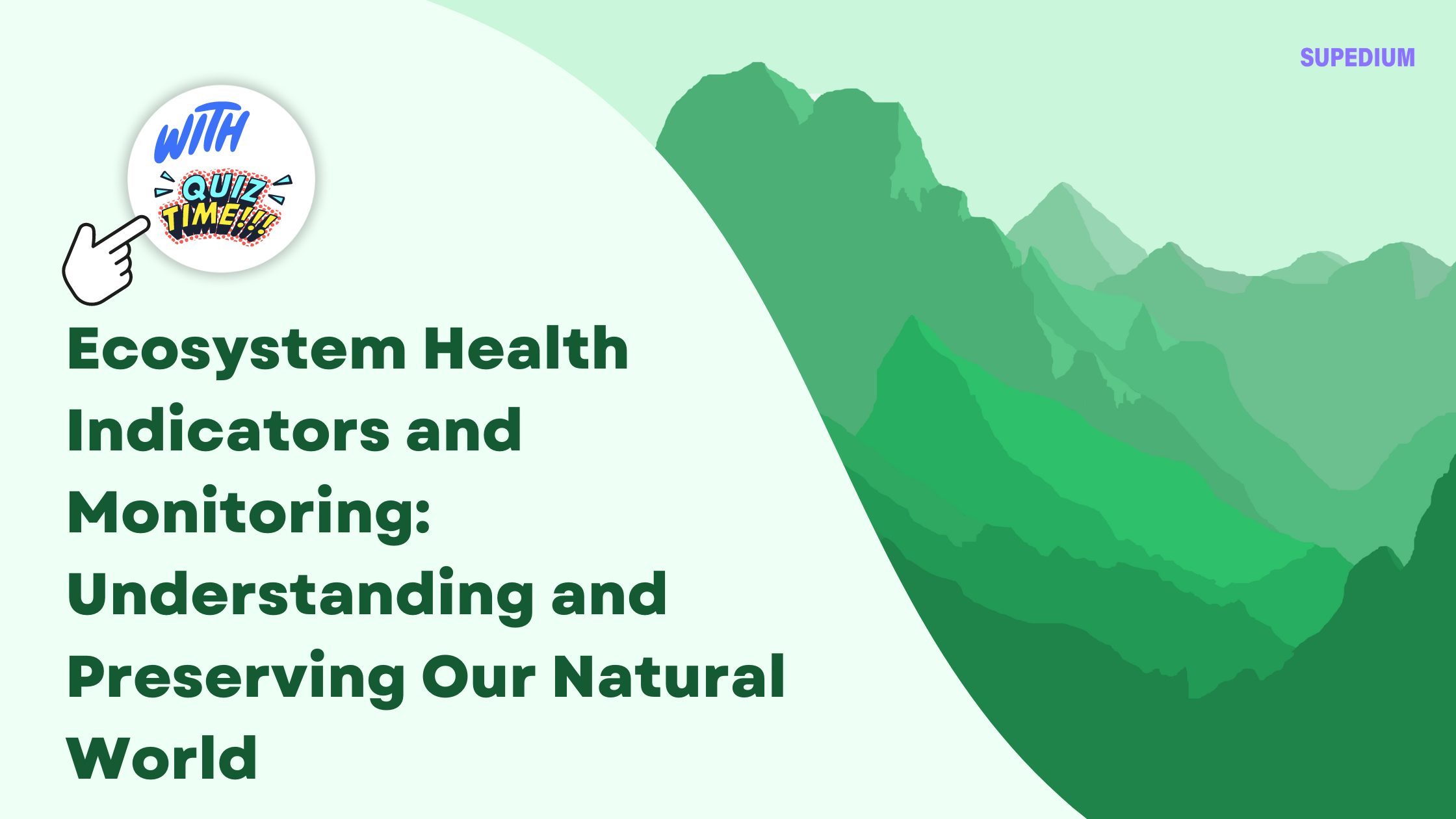Table of Contents
![]()
Ecosystem health is a crucial concept in environmental science, reflecting the overall condition and functionality of natural systems. Healthy ecosystems provide essential services such as clean air and water, fertile soils, and climate regulation. To effectively manage and conserve these systems, it is vital to monitor and assess their health using various indicators. This article explores the key indicators of ecosystem health, the methods used to monitor them, and the challenges and applications associated with this critical work.
Key Indicators of Ecosystem Health
Biological Indicators
- Species Diversity Species diversity, encompassing both species richness and evenness, is a fundamental indicator of ecosystem health. Richness refers to the number of different species in an ecosystem, while evenness describes the relative abundance of each species. High diversity often signifies a well-functioning ecosystem with stable interactions among species.
- Population Health Monitoring the abundance and density of key species provides insights into ecosystem health. Healthy populations of native species indicate a stable ecosystem, while declines or the presence of invasive species can signal underlying problems.
- Trophic Structure The food web or trophic structure of an ecosystem is another critical indicator. It includes the roles of various species, particularly keystone species that have a disproportionately large impact on their environment. Disruptions in trophic structure can lead to cascading effects throughout the ecosystem.
Chemical Indicators
- Water Quality Water quality is essential for assessing the health of aquatic ecosystems. Key parameters include pH levels, nutrient concentrations (such as nitrogen and phosphorus), and pollutants like heavy metals and pesticides. Deviations from normal ranges can indicate contamination or eutrophication.
- Soil Quality Soil health is determined by factors such as organic matter content, contaminant levels, and soil fertility. Healthy soils support plant growth and contribute to overall ecosystem stability. Monitoring soil quality helps identify issues like erosion or pollution.
Physical Indicators
- Habitat Structure The physical structure of habitats, including vegetation cover and characteristics like erosion or sedimentation, reflects ecosystem health. Changes in habitat structure can affect the species that depend on it and signal shifts in ecosystem function.
- Climate Variables Climate variables, including temperature trends, precipitation patterns, and extreme weather events, influence ecosystem health. Monitoring these variables helps assess the impacts of climate change and its effects on ecosystems.
Monitoring Techniques and Methods
Field Surveys and Sampling
Field surveys involve direct observation and data collection from ecosystems. Techniques such as transects and quadrats are used to assess species diversity, population health, and habitat conditions. These surveys provide valuable baseline data and help track changes over time.
Remote Sensing
Remote sensing technologies, including satellite imagery and aerial photography, offer a broader perspective on ecosystem health. Geographic Information Systems (GIS) enable the analysis of spatial data, helping to monitor large areas and detect changes that may not be visible from the ground.
Laboratory Analysis
Laboratory analysis is crucial for assessing chemical indicators. Water and soil testing provide detailed information on pollutants, nutrient levels, and other chemical properties. Biological assays can also be conducted to assess the presence of contaminants and their effects on organisms.
Automated Monitoring Systems
Automated systems, such as sensor networks and drones, offer continuous and real-time monitoring capabilities. Sensors can measure environmental parameters like temperature and water quality, while drones can capture high-resolution images and data from inaccessible areas.
Citizen Science
Citizen science involves the public in monitoring efforts through community-based data collection. Platforms and apps facilitate the participation of volunteers in tracking species, reporting environmental changes, and contributing to large-scale monitoring projects.
Case Studies and Examples
Aquatic Ecosystems
In coral reef ecosystems, indicators such as coral cover, species diversity, and water quality are used to assess health. Monitoring these indicators helps detect issues like bleaching events and pollution. Freshwater lakes are assessed through parameters like nutrient concentrations and biodiversity to track changes and manage water resources.
Terrestrial Ecosystems
Forests are monitored using indicators like tree health, species composition, and soil quality. Grasslands and savannas are assessed for vegetation cover, soil conditions, and the presence of invasive species. These indicators help manage conservation efforts and assess the impacts of land use changes.
Urban Ecosystems
Urban ecosystems, including green spaces and parks, are monitored for air and water quality, vegetation health, and biodiversity. Assessing these indicators helps address the challenges of urbanization and promotes sustainable urban planning.
Challenges and Considerations
Data Accuracy and Reliability
Ensuring the accuracy and reliability of data is crucial for effective monitoring. Variability and precision must be addressed through proper calibration and standardization of methods. Reliable data is essential for making informed management decisions.
Temporal and Spatial Scales
Monitoring must consider both temporal and spatial scales. Long-term data collection is necessary to identify trends and changes over time, while spatial scales must be appropriate for capturing local and global patterns. Balancing these scales is critical for effective ecosystem management.
Integration and Interpretation
Integrating multiple indicators and interpreting data within broader ecological and socio-economic contexts is essential for understanding ecosystem health. Combining biological, chemical, and physical indicators provides a comprehensive view of ecosystem conditions and helps guide management strategies.
Applications and Benefits
Conservation and Management
Monitoring indicators of ecosystem health informs conservation policies and regulations. By identifying areas of concern and prioritizing actions, managers can address threats and promote the recovery of degraded ecosystems.
Restoration Efforts
Assessing indicators helps evaluate the success of restoration projects. By tracking changes in ecosystem health, adaptive management strategies can be developed to enhance restoration outcomes and address emerging issues.
Public Awareness and Education
Communicating ecosystem health to the public raises awareness about environmental issues and promotes sustainable practices. Educational programs and outreach initiatives help engage communities in conservation efforts and foster a sense of responsibility towards the environment.
Future Directions
Advances in Technology
Emerging technologies, such as artificial intelligence and machine learning, are enhancing monitoring capabilities. Innovations in remote sensing, data analysis, and automated systems are improving the accuracy and efficiency of ecosystem health assessments.
Enhancing Global Collaboration
Global collaboration is essential for addressing environmental challenges. International monitoring programs and data sharing facilitate the exchange of knowledge and best practices, promoting coordinated efforts to protect ecosystems.
Addressing Climate Change Impacts
As climate change continues to impact ecosystems, adapting indicators and monitoring methods is crucial. Developing resilience strategies and integrating climate considerations into monitoring efforts will help address the effects of climate change and support ecosystem sustainability.
Conclusion
Ecosystem health indicators and monitoring are vital for understanding and preserving our natural world. By assessing biological, chemical, and physical indicators, employing diverse monitoring techniques, and addressing challenges, we can effectively manage and conserve ecosystems. Ongoing efforts in technology, collaboration, and climate adaptation will further enhance our ability to protect the environment and ensure a sustainable future.






Be the first to comment